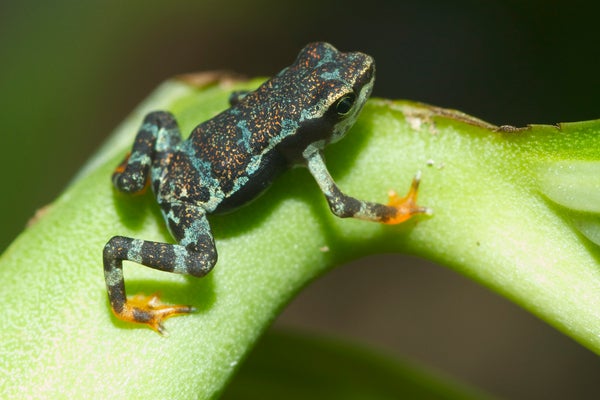This article was published in Scientific American’s former blog network and reflects the views of the author, not necessarily those of Scientific American
The world has lost at least 200 frog species since the 1970s, and hundreds more will face extinction in the coming decades, according to new research published last week in the Proceedings of the National Academy of Sciences.
The paper, by biology professor John Alroy of Australia’s Macquarie University, estimates that at least 10 percent of all frog species will disappear by 2100. We’ve already lost 3.1 percent, according to his calculations.
Habitat loss and pollution have likely caused some of the extinctions so far, but the primary driver has been the deadly chytrid fungus (Batrachochytrium dendrobatidis or Bd), which has spread around the globe over the past 40 yearsvia the pet trade and other human activities. The fungus attacks the epidermis and interferes with breathing and water intake and is fatal in many amphibian species. It has previously been blamed for at least 100 extinctions. Alroy now calculates that the number is probably much higher.
On supporting science journalism
If you're enjoying this article, consider supporting our award-winning journalism by subscribing. By purchasing a subscription you are helping to ensure the future of impactful stories about the discoveries and ideas shaping our world today.
Alroy used complicated statistical analysis to determine his estimates, which would otherwise be hard to calculate by direct observation. Most amphibian species have very limited ranges in distribution and many live in remote areas such as rainforests, where they are hard to study. Many of the species on Alroy’s list have not yet been formally declared extinct because few people have spent the time and effort to look for them and confirm their disappearance.
Although Alroy wrote that the lack of available data for some regions means that the actual rate of extinction may be much higher than his estimated 10 percent, his analysis did reveal several hotpots for extinction risk, including most of Central America, Brazil, Madagascar, Australia and New Guinea, all of which also contain high numbers of endemic species. The Southeastern U.S. and Europe appear to be the safest areas for frogs, although the chytrid fungus remains a threat in both regions. He also noted that the extinction rate began to climb in the 1980s after chytrid was first observed.
Alroy wrote in the paper that his estimates are “extremely conservative.” He also noted that under the best case scenario frogs are currently disappearing several orders of magnitude faster than the normal background rate of extinction—the expected rate at which species would evolutionarily disappear—which previous research has estimated to be between 5.2 and 9.5 percent per million years. The results of his recent research suggest, as he wrote, “a runaway train of extinction” that is “likely to produce what would be seen as a global mass extinction.”
In fact, things are already getting worse than Alroy predicted. Earlier this year—just after Alroy completed his analysis—the chytrid fungus turned up on Madagascar for the first time. The island nation holds about 7 percent of the world’s amphibian species, most of which live nowhere else and, if Alroy’s paper is any indication, may not live there much longer.
Photo: The critically endangered Pirre Harlequin frog (Atelopus gylphus) of Panama and Colombia, one of the frogs mentioned in the new paper. Photo by Brian Gratwicke, Smithsonian Conservation Biology Institute. Used under Creative Commons license
Previously in Extinction Countdown:
